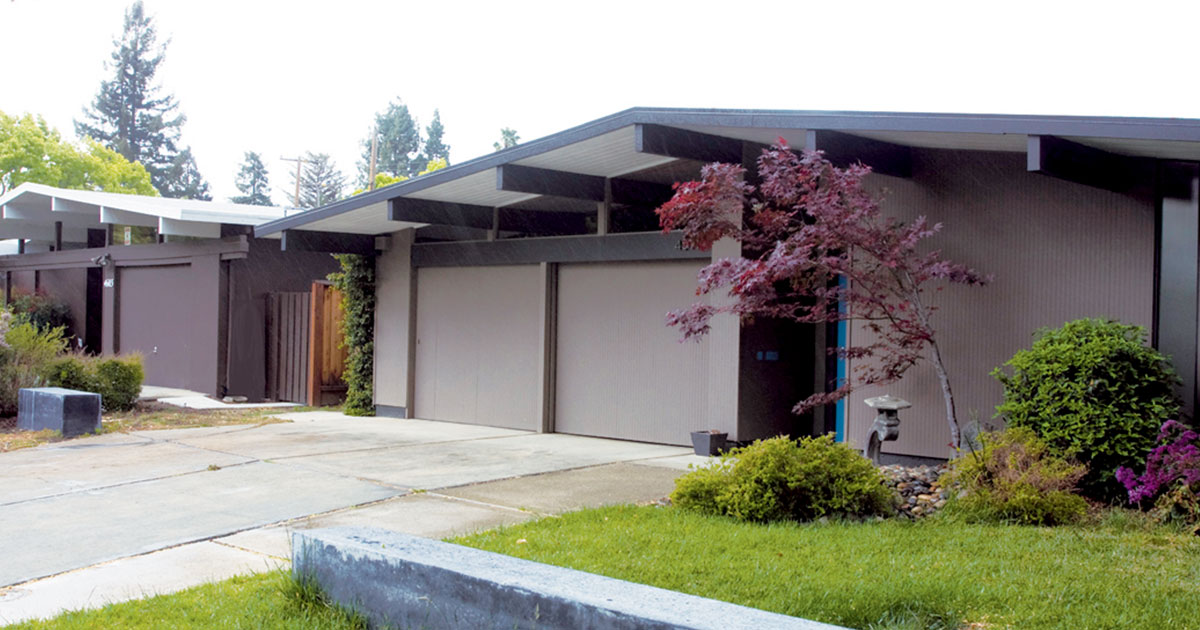Eichler Garage Doors

When trouble develops with Eichler sliding garage doors and the local garage-door outfit is called to the scene, the company's first response to the question "can you fix it?" tends to be: "Nope, but I've got a ranch-style metal roll-up with inset windows I can put in for you!" Informed that their original doors can't be saved, most Eichler owners succumb to replacement doors that are ill suited to their mid-century modern home.
In fact, there is no need to trash your original garage doors and accept a lesser substitute. Lesser in the sense that, since garage doors can make up fully one-half of the street-facing façade of an Eichler, their appearance has a tremendous impact on the overall look of the house. Eichler's architects placed their garage and carport areas at the front of the house in deference to the increasing importance of the automobile in postwar America. No longer was the car relegated to the rear in what used to be the "carriage house," where the horses were stabled. To maintain a smooth and harmonious facade, the architects skillfully blended the garage with the front elevation by facing it with the same siding as the rest of the house.
When those original garage doors or their sliding mechanisms finally start to breakdown, a knowledgeable garage door company can readily preserve the Eichler look—whether the homeowner elects to repair and improve the existing hardware or put in entirely new doors. According to Jeff Whittaker of Econo-Doormasters of Belmont, "Most people just aren't familiar with how to do it right." He sees two different groups of Eichler homeowners who come to him with problems.
One wants to add electric openers to their doors so they are easier to operate. Whittaker finds that often the original hardware simply needs a little attention and maintenance, and he has no trouble adding openers so that either door of the pair can be operated independently with the touch of a button. He can put in all new hardware, if necessary.
The other group is looking for a door that will allow them to have both sides open at once, an option that Eichler never offered in his designs. Again, Whittaker can meet that need while maintaining the Eichler style. He uses a single roll-up door across both openings, placing it behind the center post, which he does not recommend be removed since it provides critical structural support. The center post, says Whittaker, can be taken out only if significant reinforcements are added to the front of the garage, an expense few owners want to incur. "It's the weakest point of the Eichler garage design," he says.
The new roll-up door is blended with the front elevation by skinning it with Eichler-style siding, readily available these days from sources such as Eichler Siding. Whittaker takes it a step further, preferring to use a four-section instead of the standard five-section roll-up, reducing the horizontal lines along the section breaks. The result is a door that blends harmoniously with the front of the house, and is priced for only about 20 percent more than a generic roll-up.
A note about safety. All garage-door openers sold in California since 1993 are required by law to include a monitored non-contact safety reversing device, or safety edge, that stops and reverses a closing garage door. This is usually a photo-electric "eye" that will turn off the automatic opener mechanism if an object comes between the door and the edge of the opening. Make sure that this safety feature is included in your installation.




